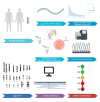Spectrum and frequency of genetic variants in sporadic amyotrophic lateral sclerosis
- PMID: 37223130
- PMCID: PMC10202555
- DOI: 10.1093/braincomms/fcad152
Spectrum and frequency of genetic variants in sporadic amyotrophic lateral sclerosis
Abstract
Therapy of motoneuron diseases entered a new phase with the use of intrathecal antisense oligonucleotide therapies treating patients with specific gene mutations predominantly in the context of familial amyotrophic lateral sclerosis. With the majority of cases being sporadic, we conducted a cohort study to describe the mutational landscape of sporadic amyotrophic lateral sclerosis. We analysed genetic variants in amyotrophic lateral sclerosis-associated genes to assess and potentially increase the number of patients eligible for gene-specific therapies. We screened 2340 sporadic amyotrophic lateral sclerosis patients from the German Network for motor neuron diseases for variants in 36 amyotrophic lateral sclerosis-associated genes using targeted next-generation sequencing and for the C9orf72 hexanucleotide repeat expansion. The genetic analysis could be completed on 2267 patients. Clinical data included age at onset, disease progression rate and survival. In this study, we found 79 likely pathogenic Class 4 variants and 10 pathogenic Class 5 variants (without the C9orf72 hexanucleotide repeat expansion) according to the American College of Medical Genetics and Genomics guidelines, of which 31 variants are novel. Thus, including C9orf72 hexanucleotide repeat expansion, Class 4, and Class 5 variants, 296 patients, corresponding to ∼13% of our cohort, could be genetically resolved. We detected 437 variants of unknown significance of which 103 are novel. Corroborating the theory of oligogenic causation in amyotrophic lateral sclerosis, we found a co-occurrence of pathogenic variants in 10 patients (0.4%) with 7 being C9orf72 hexanucleotide repeat expansion carriers. In a gene-wise survival analysis, we found a higher hazard ratio of 1.47 (95% confidence interval 1.02-2.1) for death from any cause for patients with the C9orf72 hexanucleotide repeat expansion and a lower hazard ratio of 0.33 (95% confidence interval 0.12-0.9) for patients with pathogenic SOD1 variants than for patients without a causal gene mutation. In summary, the high yield of 296 patients (∼13%) harbouring a pathogenic variant and oncoming gene-specific therapies for SOD1/FUS/C9orf72, which would apply to 227 patients (∼10%) in this cohort, corroborates that genetic testing should be made available to all sporadic amyotrophic lateral sclerosis patients after respective counselling.
Keywords: amyotrophic lateral sclerosis; genetics; motor neuron disease.
© The Author(s) 2023. Published by Oxford University Press on behalf of the Guarantors of Brain.
Conflict of interest statement
The authors report no competing interests.
Figures






References
-
- Brown RH, Al-Chalabi A. Amyotrophic lateral sclerosis. N Engl J Med. 2017;377(2):162–172. - PubMed
-
- Miller TM, Cudkowicz ME, Genge A, et al. . Trial of antisense oligonucleotide tofersen for SOD1 ALS. N Engl J Med. 2022;387(12):1099–1110. - PubMed
-
- Müller K, Brenner D, Weydt P, et al. . Comprehensive analysis of the mutation spectrum in 301 German ALS families. J Neurol Neurosurg Psychiatry. 2018;89(8):817–827. - PubMed
LinkOut - more resources
Full Text Sources
Miscellaneous
